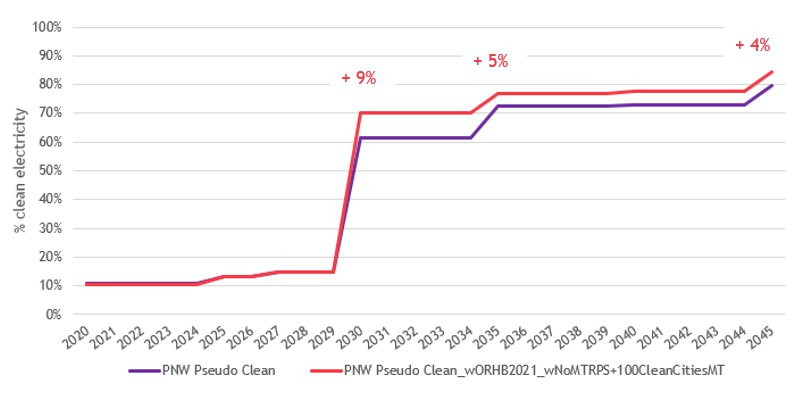Clean Policy Analysis
| Note: Data for the 2021 Power Plan was frozen in April 2020, and therefore Oregon’s new clean policy and Montana’s repeal of the RPS are not reflected in the clean policy analysis. See "Update to Clean Energy Policy Analysis" for more information. |
In past analyses, the power plan represented state level mandates (for example, a state renewable portfolio standard) as parameters in its models. However, since the Seventh Power Plan, significant clean energy policies and goals have been introduced. With the development of state clean policy mandates and goals, utility, and community clean goals, and decarbonization efforts, the Council needed to take a new approach in order to reflect the current reality. For example, there is no state level RPS or clean policy in Idaho. However, Idaho Power and Avista – who combined serve about 70% of the state’s sales – have 100% clean energy goals that we would otherwise not capture if we only included mandated state-level policies.
For the purposes of this analysis, the Council included all clean policies and goals at the state, utility, and community level that were framed as a percentage of sales obligated to meet a percentage target (e.g. Washington’s policy of 100% clean, non-emitting electricity by 2045). This excludes economy-wide greenhouse gas reduction goals framed as reducing emissions by a percent below a historic year’s levels (e.g. Oregon’s goal of reducing emissions 45% below 1990 levels by 2035), although oftentimes these efforts are largely captured in clean policies when applicable.
While not all of these clean policies and goals are binding in a legal sense, they do hold weight and have momentum behind them that cannot be ignored when reflecting regional and WECC-wide clean policy obligations. For example, if an IOU proclaims a goal of 100% clean energy by 2045, the long-term decisions it makes, including integrated resource planning and resource acquisition, are in response to- and in alignment with- that goal. While there may not be penalties like that for non-compliance of a state mandate, there are consequences of a utility not meeting their goals. This could include not making profits for their shareholders and not keeping promises to their ratepayers (who could take their business elsewhere to get the clean energy they ask for).
The Council developed a WECC-wide clean policy repository of renewable and clean goals from the state level down to the municipal level. When developing the power plan, the Council must freeze a dataset for use in the analysis. In this case, all goals and policies that were adopted by April 2020 were included. For policies that have been adopted but are still undergoing rulemaking processes, staff have included and reflected them to the best of our ability with the information available – and incorporating stakeholder review and input. Policies and goals that were proposed but not formally adopted or issued by the time the dataset was frozen are not included in the state level and regional analysis. However, the clean policy repository is updated on a regular basis to continue to reflect the latest ongoing electricity decarbonization efforts at the state, utility, and community level.
Summary of state level renewable and clean policies and goals – as of April 2020
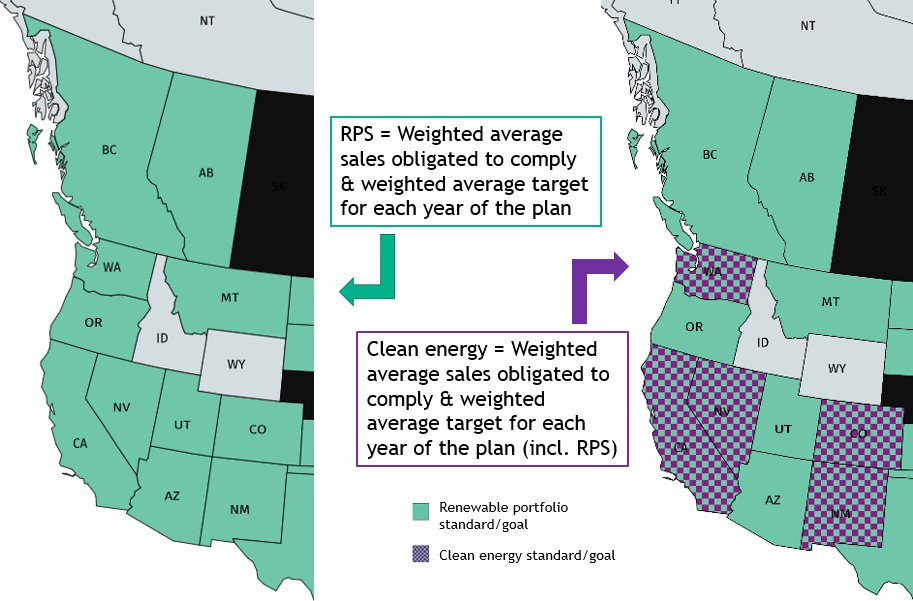
In the 2021 Power Plan, the Council took a multi-layered approach to capturing clean policies and goals and aggregating them to the state and regional level. Staff performed a state-by-state analysis, aggregating the policies into a single state-wide clean energy obligation (representing 100 percent of sales obligated to meet a percent of renewable and clean electricity supply, by year) for each year of the power planning horizon. In some states, like Washington, the overall state legislation largely encompasses the individual utility and community goals. In other states, like Idaho, in the absence of a state-level policy, the Council developed state pseudo clean energy targets by aggregating the utility and community goals to create a state-level obligation.
Staff aggregated three levels of targets for each state (and subsequently, each region – PNW and WECC): RPS, Clean, and Pseudo Clean. The three levels ultimately each reflect a weighted average annual target that represents 100% of the state’s sales. The RPS and pseudo clean targets were included in the models as mandatory obligations.
Aggregating Clean Energy Policies and Goals
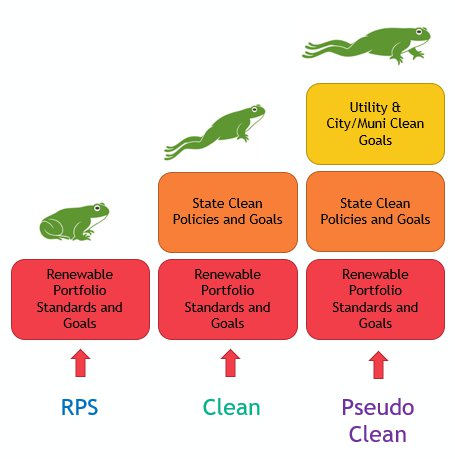
See the Council’s clean policy repository and staff presentations from June 2020 and August 2020 for detailed analysis and visuals on how each state target was developed. This analysis was presented to and vetted by several advisory committees in the development of the 2021 Power Plan. An example of each level and aggregation is below.
RPS
In Oregon, the RPS target varies based on the size of utility (see graphic to the right). In order to understand what Oregon’s state target is when representing 100% of state sales, we apply a weighted average to the individual targets and the percentage of sales they represent. The following chart shows the mandated targets for each compliance group – 50% RPS by 2040 for IOUs, 24% RPS by 2025 for large consumer owned utilities (COUs), 10% RPS by 2025 for small COUs, and 5% RPS by 2025 for even smaller COUs.
Oregon RPS Targets – Actual and Weighted Average
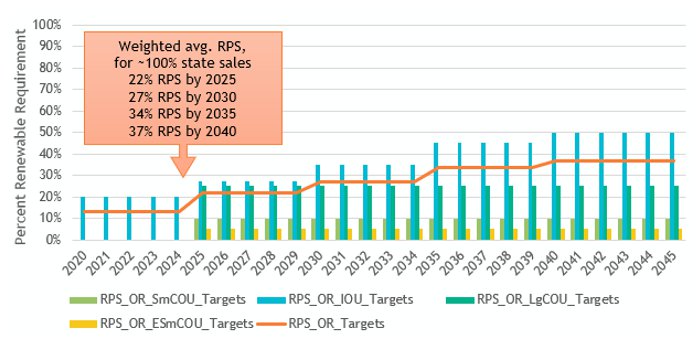
When representing 100% of Oregon’s sales, the weighted average RPS target for the state is 37% by 2040. When the same logic is applied to each state in the PNW, including 100% of Montana rather than just the NW Power Act portion, the resulting aggregated PNW renewable target is 17% by 2040.
PNW RPS Targets as of April 2020 – Assuming 100% state sales for WA, OR, ID, and MT
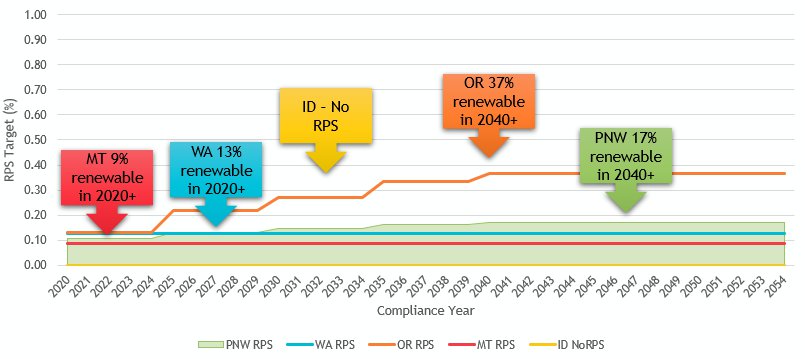
Clean
The clean target represents the previous power plan logic of representing only state-mandated policies in the models. It is the aggregation of state renewable portfolio standards and state clean policies. At the time the data was frozen for the 2021 Power Plan, Washington was the only state in the region with a state-mandated clean policy. When combining the state RPS (which has already been aggregated to 100% of state sales), the clean aggregate for Washington is 13% through 2029, and 100% in 2030 and each year thereafter. It is important to note that the large ramp-up between 2029 and 2030 is reflective of targets only; in reality, clean energy implementation plans will reflect achievement towards targets. In addition, these targets are not reflective of the existing resource mix, which in several cases across this analysis already meets or surpasses these targets.
Washington Clean Target: Weighted Avg RPS, CETA, Weighted Avg Clean
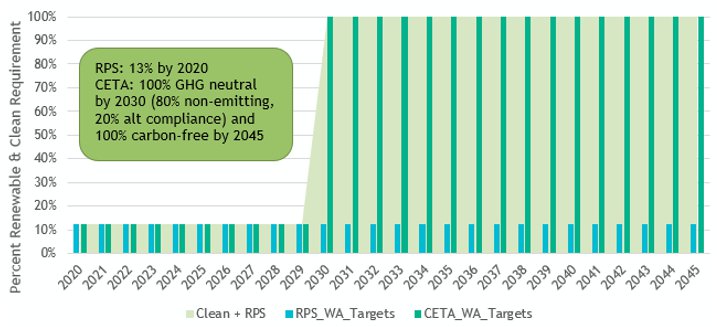
Because Washington is the only PNW state with a state-level clean policy reflected in this analysis, the state RPS weighted averages are added to Washington’s clean target to create a PNW clean aggregated target that reaches 62% by 2040.
PNW Clean + RPS Targets as of April 2020 – Assuming 100% state sales for WA, OR, ID, MT
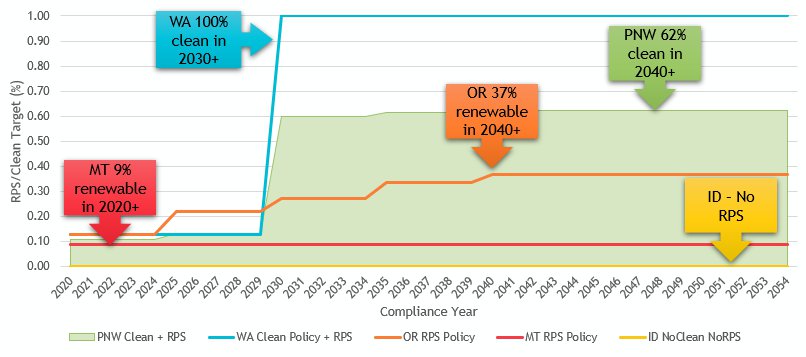
The final step to developing a pseudo clean energy target for the region is to include and aggregate the utility, city, and community clean goals for each state. A relatively simple example of this is the state of Idaho. Idaho does not have any state-level RPS or clean policy, yet it does have utility and community clean goals. Under previous power plan logic, we would not be capturing any of these goals, but as you can see, these goals represent a significant portion of Idaho’s state sales and should be included in our analysis. Idaho Power and Avista (together they account for just over 70% of Idaho’s state sales in 2018) each have 100% clean energy targets in 2045. In addition, the city of Boise has a 100% clean target by 2035 that, while the city is served primarily by Idaho Power, serves to push a portion of the state’s sales obligated to meet the Idaho Power target to an earlier date. The end result is a state pseudo clean target of 71% by 2045.
Idaho Pseudo Clean Energy Target – 100% state sales
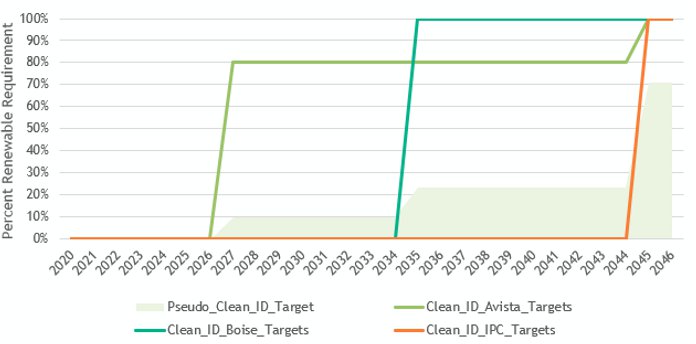
With the same logic and methodology applied to the other PNW states, the result is a region-wide (including 100% of Montana in this case) pseudo clean target of 80% by 2045.
PNW Pseudo Clean as of April 2020 – Assuming 100% state sales for WA, OR, ID, and MT
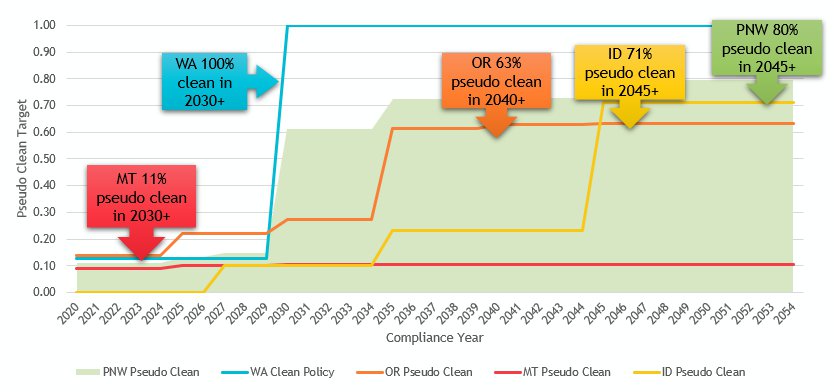
The Council’s models and resource strategy must meet the region’s RPS targets and the region’s pseudo clean targets. To understand the significance of capturing the utility and community clean goals in a state and regional pseudo clean target rather than just state-level mandates, the following figure represents each level of aggregation: RPS, Clean, and Pseudo Clean.
Comparison of PNW Clean Targets – Assuming 100% state sales for WA, OR, ID, and MT
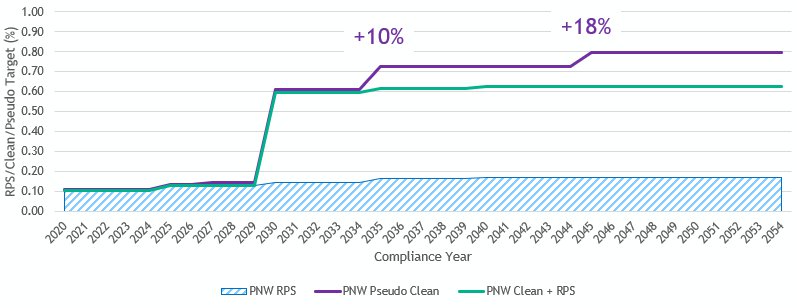
The Clean and Pseudo Clean targets do not deviate until 2035, when the pseudo clean target increases to 71% while the clean target increases to 61%. In the end, the pseudo clean target is 80% while the clean target is 62%.
The same analysis was performed for each state within the United States portion of the western interconnect. In a few states, there are state-level goals that are not legally binding. However, given the logic regarding including goals above, this analysis treats goals as mandatory compliance. The US-portion WECC pseudo clean target reaches 55% by 2040 and 80% by 2050.
US WECC Pseudo Clean – Assuming 100% state sales
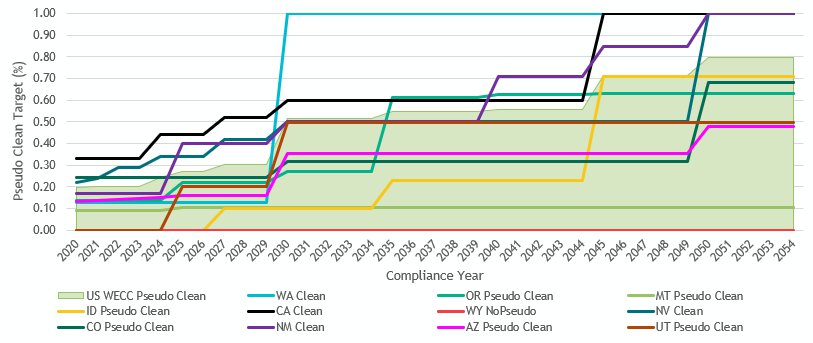
Similar to the region, the clean and pseudo clean targets don’t diverge from each other immediately. By the end, when all targets are accounted for, the pseudo clean target is 80% clean in 2050, while the strictly clean target is 68%.
Comparison of US WECC Clean Targets – Assuming 100% state sales
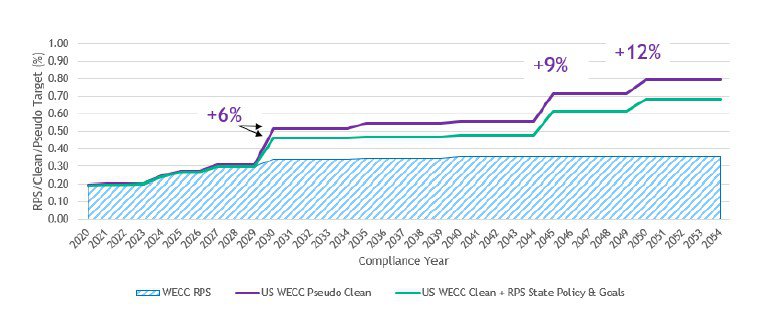
Update to Clean Energy Policy Analysis
Data for the 2021 Power Plan was frozen in April 2020. However, there have been major state policy changes within the region that required further analysis to determine the overall effect on the pseudo clean policy targets used within the plan analysis. On May 14, 2021, Montana Governor Greg Gianforte signed House Bill 576, repealing the Montana Renewable Power and Rural Economic Development Act of 2005 and effectively annulling the Montana RPS in its entirety. Further, in July 2021, Oregon Governor Kate Brown signed House Bill 2021, mandating a 100% clean electricity supply by 2040 for independent owned utilities (IOUs) and electricity service suppliers. The bill phases in greenhouse gas reductions below baseline emissions (average 2010-2012 emissions) of 80% by 2030, 90% by 2035, and 100% by 2040. It also precludes new fossil-fuel projects from being sited in the state of Oregon.
By incorporating the new Oregon clean policy and removing the Montana RPS, the pseudo clean policy analysis changes are modest. From 2020-2029, there are no changes in the percent of clean electricity supply target for the region. In 2030, the updated pseudo clean target diverges from the pseudo clean target used in the power plan analysis – increasing 9% from 61% clean to 70% clean. The difference between the two narrows five years later in 2035 to just 5%. In terms of resource mix, this updated pseudo clean analysis suggests that more clean energy will be needed sooner (in 2030) than was reflected in the original pseudo clean targets, but after that throughout the planning horizon the pseudo clean energy targets are within 5% of each other. This updated pseudo clean energy analysis is for narrative purposes only and is not reflected in the final plan analysis.
Comparison of PNW Pseudo Clean Targets - Assuming 100% state sales
